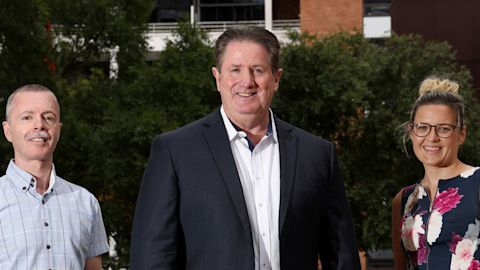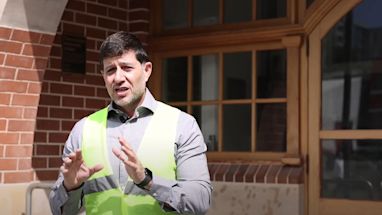Schools and apartment buildings are discovering the power in community to get the best renewable energy deals.
Until recently, it was mostly big companies that secured competitive 100% renewable power purchase agreements (PPA).
Now many small to medium sized enterprises, including apartment blocks, are finding ways to purchase 100% renewable electricity.
National strata management company PICA Group and Ascham School in Sydney’s eastern suburbs explain how they negotiated their deals.
This strata management company has paved the way for group energy deals
PICA Group is a strata management company responsible for thousands of properties across Australia. It was also the first company of its kind in Australia to secure a 100% renewable electricity agreement.
This agreement has paved the way for other groups, such as apartment buildings and schools, to negotiate their own renewable energy deals.
“The power of community is the opportunity here,” PICA executive general manager Mark Glass said.
“Interested apartment owners can join their strata committee. And their strata committee can work with other strata committees to form a collective to gain a competitive renewable electricity deal,” Glass said.
“Now that we’ve done it, and a successful example exists, it will be easier for buildings of any type to join collectives and work with partners – such as local government, strata companies, and energy brokers – to help them navigate the process.”
How PICA Group secured its first power purchase agreement
Up to 60% of the energy used in an apartment block comes from the common areas.
Pools, gyms, elevators and corridors that need to be lit and cooled make residential apartment buildings power hungry “hot spots”, Mark Glass said.
Acutely aware of how much energy PICA’s 12,000 apartment buildings consume, many individuals within the group felt a responsibility to reduce environmental damage.
“Owners corporations are becoming increasingly aware of carbon emissions and are motivated to reduce the footprint of their buildings,” PICA Group chief executive officer Wayne Walker said.
As PICA is connected to so many apartment blocks, it made sense to group multiple buildings together to negotiate a competitive corporate power purchase agreement.
“Power purchase agreements have been around for a long time, but they’ve normally been the domain of single entity organisations, usually manufacturers, universities, airports, shopping centres and so on,” Mark Glass said.
Inking the first power purchase agreement for a strata management company was not without its challenges.
These agreements generally have a 10-year minimum term to enable the renewable energy generator to recover investment costs.
To work within the maximum term allowed for strata electricity contracts in NSW, PICA Group needed its contract term to be 3 years, and to avoid annual price increases.
The group made it happen.
A win–win solution
Through its inner Sydney brand, Dynamic Property Services, PICA Group approached 65 buildings to take part in the deal and 64 accepted. 55 of these buildings are within the City of Sydney local area.
A joint tender was put out to the market for an annual volume of 20 gigawatt hours. This represents a much stronger buying power than an individual apartment building seeking an electricity deal on its own.
The collective secured competitive offers from several major energy retailers.
Following negotiations, PICA Group partnered with 2 solar farms in regional NSW in a 3-year, 100% solar electricity agreement to power the common areas of the apartment buildings.
“By leveraging the collective buying power, our agreement saved each building a significant amount of money, as well as an impressive cut in emissions,” Glass said. “And there were no upfront costs or on-going maintenance costs.”
“This was empowering for the apartment owners and residents. They realised they now had a pool of savings they could use for building upgrades. Energy efficiency upgrades could reduce costs and environmental damage even more,” added Glass.
The power of community
PICA Group’s renewables win is testament to the power of a collective. Mark Glass recommends people in smaller buildings band together, whether that be residential or schools or small businesses.
“If individual buildings can take steps to go green it could really change the landscape. We started small with a handful of buildings and expanded from there through aggregation, and we’ll do more agreements with more groups of buildings in the future,” he added.

Ascham School reaps the group energy rewards
Matthew van der Linden, CEO of energy retailer Flow Power said,: “The education sector is uniquely placed to benefit from corporate renewable energy agreements because the longevity of schools [means] they can plan for the long term and reap the benefits long-term.”
And in late 2018, Ascham School became the first school in NSW to ink a long-term deal with Flow Power.
Under this agreement, the day and boarding school for girls located in Edgecliff, Sydney, is sourcing 90% of its power from regional wind and solar farms over the next 10 years.
Business manager Candice Heapes championed the deal.
“We were working with a consultant on our sustainability plan when our electricity agreement came up for renewal. Considering costs had skyrocketed, and we like to explore innovative approaches to reduce our environmental impact, it seemed like a good time to investigate a power purchase agreement,” Heapes said.
Guided by their environmental consultant, Heapes contracted expert legal advice for the negotiations and worked with external auditors on the accounting treatment. She developed a business case and gained the support of the head of school and the school council.
Almost 3 years into their 10-year deal, Heapes reflected,
“It’s good to realise you don’t need the whole package and that it’s best to choose an approach that works for your organisation with its existing resources. We didn’t purchase Large-scale Generated Certificates because they didn’t appear to add value to our core business. And we took the ceiling price option to mitigate against spot pricing. They’ve proved to be good decisions for us.”
Heapes recommended the following tips for other organisations:
- Do your research.
- Engage expert advice.
- Make things simple – you don’t need the whole package like meters on every building and to monitor consumption every month.
- Make sure the numbers stack up for your organisation.
Renewables become a teaching aid at Ascham School
Andrew Powell, head of Ascham School, said the community has been engaging well with the power purchase agreement, and the benefits have been many.
“As well as the economic benefits, there's the opportunity to source renewable energy, and then there's the teaching benefits”.
“The girls are really looking at what we're doing around our electricity consumption, around waste and around being able to recycle as much as we possibly can,” Powell added.
Flow Power gives the school real-time statistics about its electricity usage, so students in maths and sciences classes can learn how and when power is used.
“We are the first school that has undertaken this and it would be great to see other educational institutions follow,” said Powell.

We all need to act to get to net zero by 2035
This is the critical decade of climate action. Based on the latest science, and considering Australia’s circumstances, the Climate Council concluded Australia should reduce its emissions by 75% below 2005 levels by 2030, and achieve net zero emissions by 2035.
To safeguard our way of life, we urgently need more residents and businesses to purchase 100% renewable electricity.
Our goal at the City of Sydney is to get our whole local government area – all residents, businesses, and organisations – to “net zero” emissions by 2035.
We purchase 100% renewable electricity from wind and solar farms in regional NSW to cover all City of Sydney operations - 115 buildings, 75 parks, 5 pools and 23,000 street lights.
But we need your help to green the grid, reduce emissions and curb the climate change trajectory.
Where to get more information
If you’d like to know more about power purchase agreements or find ways you can purchase 100% renewable electricity, email us at renewableelectricity@cityofsydney.nsw.gov.au. We’d like to help you.
To start your organisation’s renewable energy journey, become a member of the Business Renewables Centre Australia - a not-for-profit program from Climate-KIC Australia, WWF-Australia’s Renewable Energy Buyers Forum and the Institute for Sustainable Futures (UTS).
The BRC-A offers guides, networking and partnership opportunities, and a regular buyer’s bootcamp. Membership is free.
Not ready yet?
If a power purchase agreement is unviable right now, an accredited 100% GreenPower electricity plan is a great option.
Published 9 November 2021, updated 15 November 2021



